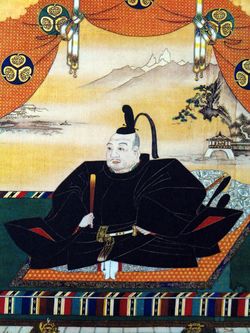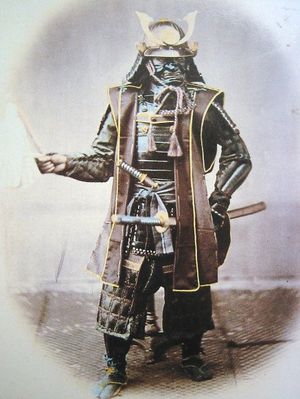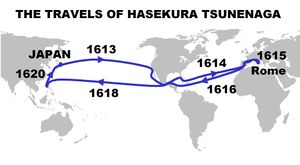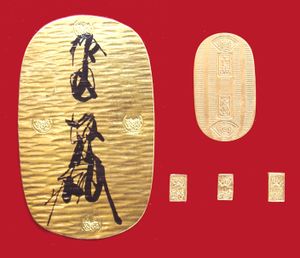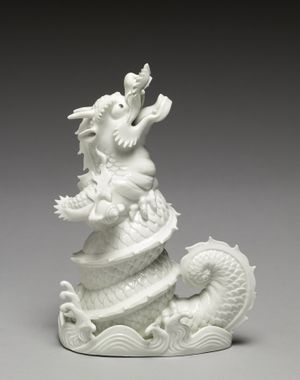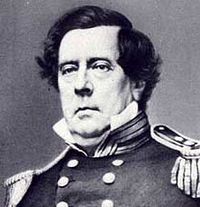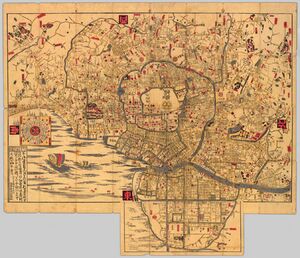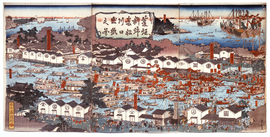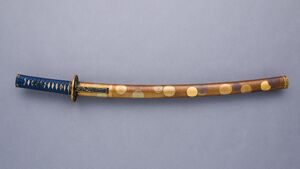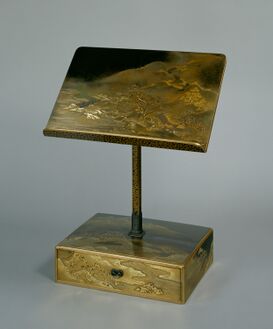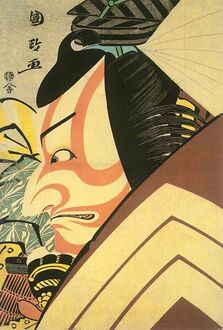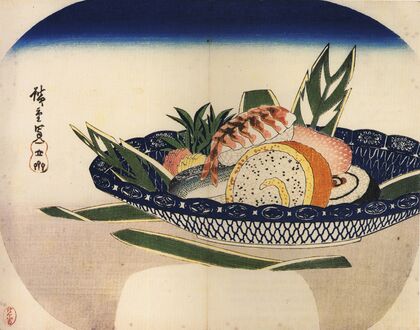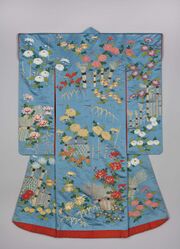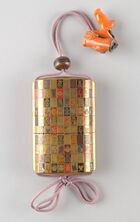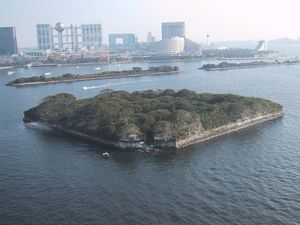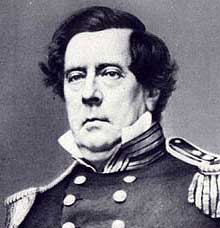فترة إدو
| جزء من سلسلة عن |
| تاريخ اليابان |
|---|
 |
فترة إدو (باليابانية: 江戸時代) سنوات (1603-1868 م.) هي آخر الفترات من تاريخ اليابان القديم، مهدت هذه الأخيرة لقيام فترة (أو عهد) "مييجي"، وقد اعتبرت هذه الأخيرة بداية التاريخ الحديث للبلاد. الخروج من اضطراب فترة سـِنگـُكو، اتسمت فترة إدو بالنمو الاقتصادي والنظام الاجتماعي الصارم وسياسات خارجية انعزالية، وعدد سكان مستقر وسلام دائم واستمتاع شعبي بالفنون والثقافة، ويشار إليها بالعامية بإسم Oedo (大江戸, Oo-Edo, "إدو العظيمة").
تشتق الفترة اسمها من إدو (الآن طوكيو)، حيث في 24 مارس 1603، تأسست الشـُگونية بشكل رسمي على يد تكوگاوا إيـِىياسو. انتهت الفترة بـ استعراش مـِيْجي و حرب بوشين، التي استعادت الحكم الإمبراطوري في اليابان.
. . . . . . . . . . . . . . . . . . . . . . . . . . . . . . . . . . . . . . . . . . . . . . . . . . . . . . . . . . . . . . . . . . . . . . . . . . . . . . . . . . . . . . . . . . . . . . . . . . . . . . . . . . . . . . . . . . . . . . . . . . . . . . . . . . . . . . . . . . . . . . . . . . . . . . . . . . . . . . . . . . . . . . . .
التوكوگاوا
في سنة 1603، خلع البلاط الإمبراطوري على "تكوگاوا إيـِىياسو" (徳川 家康) لقب الـ"شوغون". كان ذلك تتويجا لمرحلة استعادت بعدها البلاد وحدتها السياسية. قام ثلاثة من الزعماء الكبار بأعباء هذه المهمة، وقد عرفت الفترة التي شهدت أحداث الوحدة باسم "فترة أزوشي موموياما" (安土桃山時代).
بدأ "توكوگاوا إيئه-ياسو" (徳川 家康) عهده بحركة أراد من خلالها أن يضمن لسلالته البقاء في السلطة. قام ومنذ 1605 م بالتنازل عن السلطة لصالح ابنه، لم يكن الأمر في الواقع إلا مناورة جديدة كان "إيئه-ياسو" في الواقع يسيطر على كافة مناصب اتخاذ القرار، كما كان يشرف بنفسه على صياغة القوانين ووضع المراسيم. وقد استمر على سيرته حتى وافه الأجل. قضى سنة 1615 م على أبناء "هيده-يوشي" عندما غزا قلعتهم في "أوساكا". اتخذ لحكومته مقرا جديد في "إيدو" (江戸) (اليوم: "طوكيو")، أصبحت المدينة بعدها أكبر وأغنى المدن في البلاد. اتخذ سلسلة من الإجراءات لإصلاح النظامين السياسي والاقتصادي، الشيء الذي مكنه من أن يبسط سيطرته على البلاد. عند وفاة "إيئه-ياسو"سنة 1616 م، كانت اليابان قد أصبحت وحدة سياسية، كما أصبحت تتمتع بنظام سياسي مستقر.
مهدت سياسة الحكم التي أرسى دعائمها "إيئه-ياسو" الطريق أمام سلالته (الـ"تـُكوگاوا") للبقاء أكثر من ثلاثة قرون من الزمن. عرفت اليابان أثناء عهد أسرة الـ"تـُكوگاوا" ولأول مرة منذ قرون عدة نوعا من الاستقرار السياسي، كما عم البلاد الأمن.
تشكل النظام الجديد
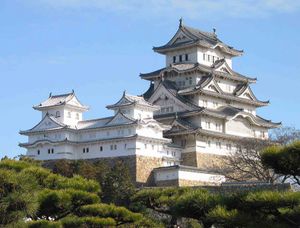
كانت نظام الحكم يرتكز على شخصية الـ"شوغون"، أصبح الأخير أكثر غنا وأكثر قوة من بقية الزعماء الإقطاعيين الـ"دائي-ميو" (大名)، يعد في جيشه أكثر من 80.000 شخص، كما يبسط سيطرته المباشرة على المدن الكبرى، الموانئ المهمة في البلاد، الطرقات والمعابر الرئيسة وغيرها. يحكم الـ"شوغون" بمفرده، يساعده مجلس مؤلف من وزراء دولة أو "روشو" ومجموعة من المستشارين أو "واكاشيدوري". كما يساعده في مهامه محافظ "إيدو"، القائم على شؤون المالية، وآخر على الشؤون الدينية... في بداية عهد فترة "إيدو" كانت اليابان تعد 270 من الـ"دائي-ميو" (الزعماء الإقطاعيون)، كانوا يتوزعون على ثلاث مجموعات:
- "شنبان دائي-ميو": أكثرهم من عشيرة وأبناء "إيئه-ياسو"،
- "فودائي دائي-ميو": أكثرهم من الحلفاء المواليين للأسرة الحاكمة،
- "توزاما دائي-ميو" من الحلفاء الذين تم إخضاعهم بعد فترة 1600 م، أغلبهم تخشى شوكتهم.
الطبقات الاجتماعية
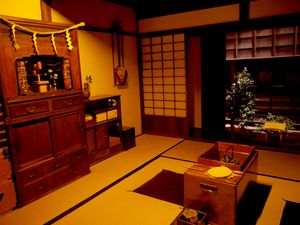

بمجرد اعتلائه سدة الحكم قام "تـُكوگاوا إيئه-ياسو" (徳川 家康) بإعادة تقسيم الأراضي والثروات كما قام بسن الطبقية في المجتمع الياباني. أصبح بالإمكان تمييز عدة طبقات على غرار طبقة المحاربين، الفلاحين، الصناع والتجار، نبلاء البلاط، رجال الكهنوت البوذيين (الرهبان) وخدام المزارات الشنتوية ثم طبقة أخيرة تعيش بمغزل عن المجتمع تعرف باسم "هينين" (يمكن ترجمتها بـ"المنبوذين").
طبقة المحاربين
المحاربون أو الـ"بوشي" (武士)، ورجال هذه الطبقة يمكن أن يكونوا من الـ"دائي-ميو" (大名) وهم كبار الزعماء الإقطاعيين، الساموراي (侍) والذين يضعون أنفسهم في خدمة أحد الزعماء، أو الـ"رو-نين" (浪人) وهم من رجال الساموراي السابقين والذين انتهت مدة خدمتهم لسبب أو لآخر (عادة عند وفاة الزعيم).
يتحكم رجال هذه الطبقة في رقاب الأفراد من الطبقات الأخرى، إلا أن الدماء لا يمكن إراقتها بهذه السهولة. يتبع كل منهم نظاما قائما على أساس الموالاة (من الولاء)، كل فرد يتبع آخرا أعلى رتبة منه وهكذا دواليك حتى أعلى الهرم. لكل منهم الحق في أن يمتلك معقلا له ولعشيرته (قد يتملك أراض بطريقة مباشرة، أو قد يكون له الحق فقط في الاستفادة مما تنتجه، كمحاصيل الأرز مثلا)، يتوجب عليهم في المقابل أن يبدو السمع والطاعة اتجاه أسيادهم وزعمائهم وأن يهبوا حياتهم إذا توجب الأمر.
يمنع على الزعماء الكبار (الـ"دائي-ميو") أن يشيدوا أكثر من قصر واحد في المقاطعة الأصلية، كما يتم استدعائهم إلى مقر الحكومة العسكرية (الـ"شوگونية") حتى يعلنوا ولائهم وطاعتهم للحاكم وفق تنظيمات خاصة بالمحاربين تعرف باسم "بوكي شوهودو" (وضعت سنة 1615 م). منذ سنة 1635 م أصبحوا مجبرين على ترك أبنائهم (كرهائن) في العاصمة "إيدو" (اليوم "طوكيو")، كما توجب عليهم الإقامة بأنفسهم عاما كاملا كل سنتين فيها. عرف هذا النظام الفريد من نوعه باسم "سان-كين كونائي" أو "الإقامة المتناوبة".
طبقة الفلاحين
يشكل الفلاحون، سواء كانوا من صغار الملاك أو الكادحين البسطاء، الأكثرية في تعداد السكان في بلاد اليابان أثناء فترة "إدو"، وعلى هذا أخضع أفراد هذه الطبقة إلى نظام أكثر شدة. كان يمنع عليهم اقتناء، بيع أو إهمال الأراضي التي يقومون بزراعتها، كما لا يحق لهم زرع أصناف أخرى من المزروعات غير تلك التي تم تقييدها في السجلات العقارية.
كانت هذه التدابير تهدف إلى منع قيام طبقة جديدة أكثر ثراء من بين ملاك الأراضي، كما كان يراد منها تعطيل عادة قديمة متبعة بين بعض من أبناء الشعب الياباني التواق إلى السفر (كان ذلك مهربا لهم من حياتهم اليومية المتعبة والشقية)، كان بعضهم يدعي أنه سيقوم برحلة حج إلى إحدى المزارات المشهورة، ثم لا يلبث أن يختفي، ممضيا بقية حياته متسكعا في الطرقات، يتمثل قوت يومه الوحيد في الصدقات التي يدفعها إليه بعض أصحاب القلوب الرحيمة.
طبقة الحرفيين والتجار
مع بداية القرن السادس عشر أخذ أفراد هذه الطبقة يتزايد باضطراد، كانت هذه تجمع بين أفرادها حرفيين وصناع من شتى المجالات بالإضافة إلى الأفراد المشتغلين بالتجارة. كان تنوع أفرادها من العوامل التي صعبت السيطرة عليها. غالبا ما كان أصحاب كل نشاط يقومون بإدارة أنشطتهم بأنفسهم. قام العديد من القرويين والذين تقع قراهم على واجهة البحر، بتنظيم نشاط الصيد وكذا عملية استخراج الملح البحري. وفي الجبال البعيدة تشكلت تجمعات تظم كل من يمتهن الحطابة، ثم أخذ أفرادها ينظمون عملية استخراج الحطب وعلى حسب الاحتياجات القائمة. وفي نفس الفترة أخذ نشاط استغلال المناجم يأخذ مكانه بين النشاطات التقليدية الأخرى التي كانت معروفة آنذاك.
كانت المدن (على غرار القرى والأرياف) تعرف نشاطا لا يكاد يهدأ. عرف نشاط صناعة النسيج نموا سريعا، وشملت الحيوية أنشطة أخرى، كصناعة الفخار، صناعة الأصبغة ومواد الطلاء، صناعة الورق، وصناعة الجعة (نوع من الخمور). مع تطور الصناعة المحلية بدأ النشاط التجاري يعرف حيوية بدوره، كان لتحسن نظام المواصلات في البلاد دوره الكبير في ذلك. أخذت الأسواق تظهر في العديد من نواحي البلاد، كانت هذه الأخيرة تشكل المحور الذي يصاحب ظهور تجمعات من السكان، ثم ما لبثت أعداد هؤلاء تتزايد حتى تشكلت تجمعات سكانية كبيرة. كانت "أوساكا" من أكبر مدن البلاد، كان أغلب تجار الجملة في اليابان يتخذونها مركزا لنشاطاتهم، كان ذلك مؤشرا لظهور طبقة وسطى جديدة (البورجوازيون) من أصحاب الأموال، قام هؤلاء بإدخال أنماط جديد في التعاملات المالية اليومية، كالقروض البنكية، أو السندات المالية.
طبقة النبلاء ورجال الدين
قام النظام بوضع رجال البلاط تحت الرقابة الصارمة. منذ سنة 1615 م تم سن ستة عشرة (16) من القوانين الخاصة بأبناء هذه الطبقة. كان النبلاء من رجال البلاط ملزمين بالتقيد بدراسة الآداب والعلوم الأخرى والامتناع عن ممارسة كل نشاط له علاقة بحمل السلاح. تم إقرار العديد من التنظيمات التي حصرت مجال نشاطات المعابد والأديرة كما أعيد تنظيم المدارس الدينية، كان الهدف من ذلك الحد من القوة المالية والروحية لهذه الطبقة. بعد فترة أولى ساد فيها التسامح، قام الشوگونات بمنع المسيحية في البلاد، كما شنوا حملة مطاردة، تم فيها اضطهاد العديد من أتباع هذه الديانة الجديدة.
العزلة وإنغلاق البلاد
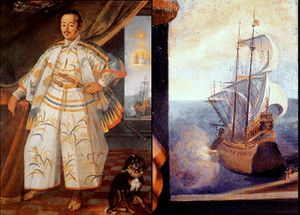
كان الـ"شـُگونات" يرون أنه يتوجب عليهم ولضمان استقرار سياسي واجتماعي في البلاد، أن يتحكموا في حركة انتقال الأشخاص. كانت الفكرة تقضي بأن يتم إغلاق كل منافذ البلاد (اليابان) على الخارج، ومنع السكان من التواصل مع بقية العالم، وقد تم تطبيق هذه الفكرة منذ القرن الـ17 م (1600 م). لم تكن هذه الحركة دون أن تلاقى صدى لدى الأجانب وبالأخص الأوروبيين، كان الإنجليز الأكثر إصرارا على كسر طوق الحظر، كانت لهم سفارات عديدة كما اشتركوا مع الفرنسيين ثم مع الروس علهم يفلحون في إقناع النظام بالعدول عن قراره، إلا أن هذه الجهود باءت كلها بالفشل. منح الـ"شوگونات" السفن البرتغالية والهولندية تراخيص تجارية خاصة ، كان يسمح لها بالرسو مرة واحدة كل سنة في جزيرة "ديشيكا" بالقرب من "ناكاساكي" على السواحل اليابانية. كانت تجارة الحرير مع الصين يحتكرها البرتغاليون، وقد تمكن الـ"شوگونات" من جني فوائد كبيرة جراء ذلك.
. . . . . . . . . . . . . . . . . . . . . . . . . . . . . . . . . . . . . . . . . . . . . . . . . . . . . . . . . . . . . . . . . . . . . . . . . . . . . . . . . . . . . . . . . . . . . . . . . . . . . . . . . . . . . . . . . . . . . . . . . . . . . . . . . . . . . . . . . . . . . . . . . . . . . . . . . . . . . . . . . . . . . . . .
العلوم الفكرية والثقافة

عم الأمن أرجاء البلاد، ونجحت الإصلاحات المالية التي تم اتخاذها كما ارتفع مستوى الإنتاجية في معظم القطاعات الاقتصادية الحيوية، كل هذه العوامل جعلت من فترة "إيدو" من أزهى الفترات التي عرفتها البلاد، أصبحت اليابان والتي كانت على موعد حاسم في تاريخها بلادا تريد أن تحتل مكانا محترما بين جيرانها.
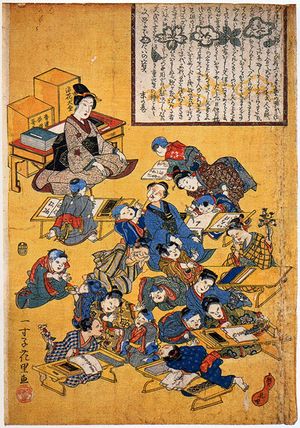
أولى مراحل الإصلاح في هذه الفترة مست القطاع التعليمي، تم تنظيم المدارس وتقسيمها حسب الطبقات المعروفة في المجتمع. في كل منطقة كانت هناك مدارس خاصة بأبناء العشائر المحلية (ويطق عليها تسمية "هانكو" بالمحلية) والتي تنتظم في معاقل خاصة بها، كانت هذه الأخيرة (المدارس) تستقبل أبناء المحاربين ممن انضووا تحت لواء العشيرة المتزعمة للمعقل. كان أغلب أبناء الشعب من سكان المدن أو الأرياف يرتاد المدارس الدينية (أو "تراكويا")، كانت هذه مفتوحة لأبناء الشعب وتخضع في تسييرها لأحدى المؤسسات الدينية التقليدية (دير، معبد، مزار ...)، والعلوم التي يتم تدريسها يغلب عليها الطابع الديني. قامت إلى جانب ذلك مدارس متخصصة في المدن الكبرى، كان روادها من أبناء كل الطبقات وكانت تدرس فيها فيها شتى أنواع العلوم والمدارك التي كانت معروفة في البلاد آنذاك.
كان لتطور نظام التعليم في البلاد أثره الإيجابي على الحياة الفكرية. ظهرت حركة جديد قام فيها جمع من المتمدرسين بعمل بحوث ودراسات شملت كامل البلاد ("كوكو گاكو" أو "الدراسات الوطنية"). أخذ هؤلاء الدارسين يبحثون في الكتابات القديمة، كان هدفهم استخراج كل النصوص التي تشبعت بالروح القومية اليابانية، فكان أن ازدهرت علوم اللغويات الببليوغرافية (الدراسة اللغوية للوثائق المكتوبة) وكذا علوم التاريخ. من رواد هذا الميدان يمكننا ذكر، "كامو نو مابوتشي" ع(1697-1769 م) و"موتو-أوري نوريناغا" والذين أصبحت أعمالها مرجعا لمن أتى بعدهما، فقد أعيد نشر ومناقشة العديد منها وبالأخص على يد "هيراتا أتسوتاني" ع(1776-1843 م). اهتم رجال الثقافة في هذا العصر بالعلوم الغربية أيضا، كانت هذه العلوم قد دخلت البلاد عن طريق التجار الهولنديين، من بين العلوم التي تناولها اليابانيين باهتمام كبير يمكننا عد: علم الفلك، الرياضيات وعلم الخرائط.
كان انتشار أفكار الـ"كونفوشية الجديدة" من أهم ما ميز الحياة الفلسفية في اليابان أثناء فترة "إدو"، ويعد "هاياشي رازان" ع(1583-1657 م) من أهم زعماء هذا التوجه الجديد. كان يركز في أفكاره على أهمية العلاقات القائمة بين الطبقات الاجتماعية، وأهمية احترامها، إلى قيمة الولاء والطاعة بين أبناء العشيرة الواحدة.
عرفت الفترة اهتمام واسعا بالروايات التاريخية، كانت في معظمها تنتهي بعبرة أو درس في الأخلاق. قام "هاياشي رازان" ع(1583-1657 م) بتصنيف تاريخ كبير للبلاد على هذه الشاكلة، كما تناول "أرائي هاكوسيكي" الفترة الأسطورية بالدراسة وأخضعها إلى ميزان علوم اللغويات الببليوغرافية.
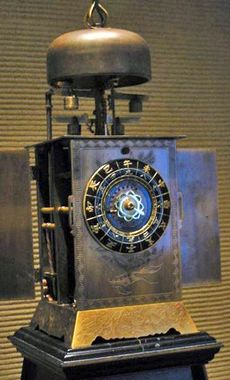
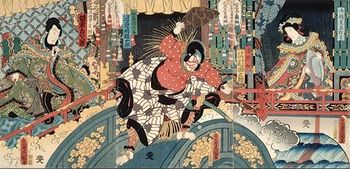
مع تحسن المستوى المعيشي للسكان في المدن، وبالأخص "كيوتو" (京都) و"أوساكا" (大阪) ظهرت ثقافة شعبية خاصة بطبقة جديدة من البورجوازيين. من أهم مظاهر هذه الموجة الجديدة كان ابتداع مسرح العرائس أولا ثم مسرح الـ"كابوكي" (歌舞伎) على يد "شيكامتسو مونزا-إيمون" (近松 門左衛門) فيما بعد. إلى جانب المسرح عرف فن القصص الشعبي مرحلة ازدهاره مع كتابات "إيهارا سائي-كاكو"، كما برز "ماتسو-أو باشو" (松尾芭蕉) كواحد من أهم أعمدة الشعر التقليدي الياباني المعروف باسم "هايكو" (俳句).
انهيار نظام الشوگونية
بعد وفاة ثالث الـ"شـُگونات" من أسرة الـ"توكوگاوا"، قادت البلاد حكومة وطنية مؤلفة من مجلس من نخبة رجال البلاط، كانت الروح الكونفوشيوسية تقودهم في عملهم. قامت هذه الحكومة بسن العديد من القوانين للحد من مظاهر العنف التي ميزت المجتمع الياباني، تم أولا تعطيل العديد من الحالات التي يتم فيها اللجوء إلى الانتحار أو الـ"سيبوكو"، بعدها بعامين تم منع عادة قديمة يقوم فيها الجيران المتخاصمين باختطاف أفراد من العوائل الأخرى واستعمالها كالرهينة ثم المقايضة بها. أصبح العديد من المحاربين (على اختلاف رتبهم) ممن أعلنوا ولاء هم للنظام الـ"شوغوني" مجرد موظفين في الدولة، تدفع لهم رواتب على قدر مرتبتهم في سلم الوظائف وليس على قدر رتبهم العسكرية. على الرغم من الجهود التي بذلتها القيادة الجديد للبلاد، والإصلاحات التي تم اتخاذها، كانت مجريات الأحداث تنذر بالأسوأ، فمنذ النصف الثاني من القرن الـ"17" (1600 م) أخذت الثورات والانتفاضات الشعبية تزداد حدة وعنفا. أصبحت موارد البلاد تتضاءل، كان النظام يعتمد على صادرات البلاد من الفضة، وكانت المقايضة تتم على أساس سعر الأرز، الذي كان يتهاوى. تم اتخاذ إصلاحات اقتصادية جديد قام بوضع خطتها أحد ألمع رجال السياسة في عصره "أرائي هاكوسيكي". إلا أن الأقدار أبت إلا أن تضاعف من حجم الخسارة، فتوالت الجوائح (الكوارث الطبيعية) على البلاد: الجفاف، الحرائق، الأوبئة، ثورات البراكين وأخيرا المجاعات.
انفتاح البلاد القسري
عام 1853 يقوم أسطول من البحرية الأمريكية يقوده "ماثيو بيري" (Matthew Perry) بكسر طوق الحظر عندما دخل عنوة خليج "إيدو" ("طوكيو" اليوم). قام قائد البحرية الأمريكية بتقديم طلب رسمي يتضمن الموافقة على فتح موانئ ومنافذ البلاد الخارجية على التجارة مع الدول الخارجية. كان وضع النظام الـ"شوغوني" هشاً، وقد ساهمت المصاعب الاقتصادية ثم الأزمات السياسية في تعقيد الوضع أكثر. بعد أخذ ورد وافق النظام الياباني على توقيع اتفاقية "كاناغاوا" في مارس 1854 م. تم بموجبها فتح مينائي "شيمودا" و"هاكوداتي" على المبادلات التجارية، كما تم ترخيص المراكب الأجنبية بالتزود في الموانئ اليابانية عند حاجتها لذلك.
بعد توقيع الاتفاقية الأولى بسنتين، عرفت البلاد مقدم القنصل الأمريكي الجديد "تاونسند هاريس"، (Townsend Harris) قام الأخير بإعداد مشروع وثيقة جديدة تهدف إلى فتح مواني جديد أخرى وكذا تسهيل التجارة وتحريرها من القيود. تمت إعادة توقيع الاتفاقية من جديد في يوليو من سنة 1858، وقد وقع عليها من الطرف الأجنبي كل من الولايات المتحدة أولا ثم تلتها كل من إنجلترا، فرنسا وأخيرا روسيا.
علاقات التجارة الخارجية

Like Hideyoshi, Ieyasu encouraged foreign trade but also was suspicious of outsiders. He wanted to make Edo a major port, but once he learned that the Europeans favoured ports in Kyūshū and that China had rejected his plans for official trade, he moved to control existing trade and allowed only certain ports to handle specific kinds of commodities.
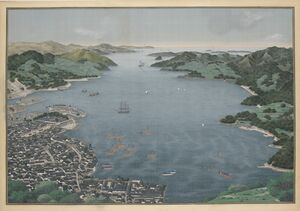
The beginning of the Edo period coincides with the last decades of the Nanban trade period during which intense interaction with European powers, on the economic and religious plane, took place. It is at the beginning of the Edo period that Japan built its first ocean-going warships, such as the San Juan Bautista, a 500-ton galleon-type ship that transported a Japanese embassy headed by Hasekura Tsunenaga to the Americas and then to Europe. Also during that period, the bakufu commissioned around 720 Red Seal Ships, three-masted and armed trade ships, for intra-Asian commerce. Japanese adventurers, such as Yamada Nagamasa, used those ships throughout Asia.
The "Christian problem" was, in effect, a problem of controlling both the Christian daimyo in Kyūshū and their trade with the Europeans. By 1612, the shōgun's retainers and residents of Tokugawa lands had been ordered to forswear Christianity. More restrictions came in 1616 (the restriction of foreign trade to Nagasaki and Hirado, an island northwest of Kyūshū), 1622 (the execution of 120 missionaries and converts), 1624 (the expulsion of the Spanish), and 1629 (the execution of thousands of Christians).
Finally, the Closed Country Edict of 1635 prohibited any Japanese from travelling outside Japan or, if someone left, from ever returning. In 1636, the Dutch were restricted to Dejima, a small artificial island—and thus, not true Japanese soil—in Nagasaki's harbor.
The shogunate perceived Christianity to be an extremely destabilizing factor, and so decided to target it. The Shimabara Rebellion of 1637–1638, in which discontented Catholic samurai and peasants rebelled against the bakufu—and Edo called in Dutch ships to bombard the rebel stronghold—marked the end of the Christian movement. During the Shimabara Rebellion an estimated 37,000 people (mostly Christians) were massacred.[1] In 50 years, the Tokugawa shoguns reduced the amount of Christians to near zero in Japan.[1]
Some Christians survived by going underground, the so-called Kakure Kirishitan. Soon thereafter, the Portuguese were permanently expelled. Members of the Portuguese diplomatic mission were executed. All Japanese subjects were ordered to register at a Buddhist or Shinto temple. The Dutch and Chinese were restricted, respectively, to Dejima and to a special quarter in Nagasaki. Besides small trade of some outer daimyo with Korea and the Ryukyu Islands, to the southwest of Japan's main islands, by 1641, foreign contacts were limited by the policy of sakoku to Nagasaki.
The last Jesuit was either killed or reconverted by 1644.[2] By the 1660s, Christianity was almost completely eradicated. Its external political, economic, and religious influence on Japan became quite limited.[3] Only China, the Dutch East India Company, and for a short period, the English, enjoyed the right to visit Japan during this period, for commercial purposes only, and they were restricted to the Dejima port in Nagasaki. Other Europeans who landed on Japanese shores were put to death without trial.
. . . . . . . . . . . . . . . . . . . . . . . . . . . . . . . . . . . . . . . . . . . . . . . . . . . . . . . . . . . . . . . . . . . . . . . . . . . . . . . . . . . . . . . . . . . . . . . . . . . . . . . . . . . . . . . . . . . . . . . . . . . . . . . . . . . . . . . . . . . . . . . . . . . . . . . . . . . . . . . . . . . . . . . .
المجتمع

During the Tokugawa period, the social order, based on inherited position rather than personal merits, was rigid and highly formalized. At the top were the emperor and court nobles (kuge), together with the shōgun and daimyo. Below them the population was divided into four classes in a system known as mibunsei (身分制): the samurai on top (about 5% of the population) and the peasants (more than 80% of the population) on the second level. Below the peasants were the craftsmen, and even below them, on the fourth level, were the merchants.[4]
Only the peasants lived in rural areas. Samurai, craftsmen and merchants lived in the cities that were built around daimyo castles, each restricted to their own quarter. Edo society had an elaborate social structure, in which every family knew its place and level of prestige.[5]
At the top were the Emperor and the court nobility, invincible in prestige but weak in power. Next came the shōgun, daimyo and layers of feudal lords whose rank was indicated by their closeness to the Tokugawa. They had power. The daimyo comprised about 250 local lords of local "han" with annual outputs of 50,000 or more bushels of rice. The upper strata was much given to elaborate and expensive rituals, including elegant architecture, landscaped gardens, Noh drama, patronage of the arts, and the tea ceremony.[6]
Then came the 400,000 warriors, called "samurai", in numerous grades and degrees. A few upper samurai were eligible for high office; most were foot soldiers. Since there was very little fighting, they became civil servants paid by the daimyo, with minor duties. The samurai were affiliated with senior lords in a well-established chain of command. The shogun had 17,000 samurai retainers; the daimyo each had hundreds. Most lived in modest homes near their lord's headquarters, and lived off of hereditary rights and stipends. Together these high status groups comprised Japan's ruling class making up about 6% of the total population.
After a long period of inner conflict, the first goal of the newly established Tokugawa government was to pacify the country. It created a balance of power that remained (fairly) stable for the next 250 years, influenced by Confucian principles of social order. Most samurai lost their direct possession of the land: the daimyo took over their land. The samurai had a choice: give up their sword and become peasants, or move to the city of their feudal lord and become a paid retainer. Only a few land samurai remained in the border provinces of the north, or as direct vassals of the shōgun, the 5,000 so-called hatamoto. The daimyo were put under tight control of the shogunate. Their families had to reside in Edo; the daimyo themselves had to reside in Edo for one year and in their province (han) for the next. This system was called sankin-kōtai.[7]
Lower orders divided into two main segments—the peasants—80% of the population—whose high prestige as producers was undercut by their burden as the chief source of taxes. They were illiterate and lived in villages controlled by appointed officials who kept the peace and collected taxes. The family was the smallest legal entity, and the maintenance of family status and privileges was of great importance at all levels of society. The individual had no separate legal rights. The 1711 Gotōke reijō was compiled from over 600 statutes promulgated between 1597 and 1696.[8]
Outside the four classes were the so-called eta and hinin, those whose professions broke the taboos of Buddhism. Eta were butchers, tanners and undertakers. Hinin served as town guards, street cleaners, and executioners. Other outsiders included the beggars, entertainers, and prostitutes. The word eta literally translates to "filthy" and hinin to "non-humans", a thorough reflection of the attitude held by other classes that the eta and hinin were not even people.[9]
Hinin were only allowed inside a special quarter of the city. Other persecution of the hinin included disallowing them from wearing robes longer than knee-length and the wearing of hats.[9] Sometimes eta villages were not even printed on official maps. A sub-class of hinin who were born into their social class had no option of mobility to a different social class whereas the other class of hinin who had lost their previous class status could be reinstated in Japanese society.[9]
In the 19th century the umbrella term burakumin was coined to name the eta and hinin because both classes were forced to live in separate village neighborhoods.[10] The eta, hinin and burakumin classes were officially abolished in 1871.[9] However, their cultural and societal impact, including some forms of discrimination, continues into modern times.[10]
النمو الاقتصادي
The Edo period passed on a vital commercial sector to be in flourishing urban centers, a relatively well-educated elite, a sophisticated government bureaucracy, productive agriculture, a closely unified nation with highly developed financial and marketing systems, and a national infrastructure of roads. Economic development during the Tokugawa period included urbanization, increased shipping of commodities, a significant expansion of domestic and, initially, foreign commerce, and a diffusion of trade and handicraft industries. The construction trades flourished, along with banking facilities and merchant associations. Increasingly, han authorities oversaw the rising agricultural production and the spread of rural handicrafts.[11]
التعداد
By the mid-18th century, Edo had a population of more than one million, likely the biggest city in the world at the time.[12] Osaka and Kyoto each had more than 400,000 inhabitants. Many other castle towns grew as well. Osaka and Kyoto became busy trading and handicraft production centers, while Edo was the center for the supply of food and essential urban consumer goods. Around the year 1700, Japan was perhaps the most urbanized country in the world, at a rate of around 10–12%.[12] Half of that figure would be samurai, while the other half, consisting of merchants and artisans, would be known as chōnin.[12]
In the first part of the Edo period, Japan experienced rapid demographic growth, before leveling off at around 30 million.[13] Between the 1720s and 1820s, Japan had almost zero population growth, often attributed to lower birth rates in response to widespread famine (Great Tenmei famine 1782-1788), but some historians have presented different theories, such as a high rate of infanticide artificially controlling population.[14]
At around 1721, the population of Japan was close to 30 million and the figure was only around 32 million around the Meiji Restoration around 150 years later.[15][12] From 1721, there were regular national surveys of the population until the end of the Tokugawa Shogunate.[13] In addition, regional surveys, as well as religious records initially compiled to eradicate Christianity, also provide valuable demographic data.[13]
الاقتصاد والخدمات المالية
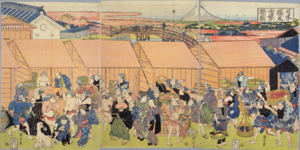
The Tokugawa era brought peace, and that brought prosperity to a nation of 31 million, 80% of them rice farmers. Rice production increased steadily, but population remained stable. Rice paddies grew from 1.6 million chō in 1600 to 3 million by 1720.[16] Improved technology helped farmers control the all-important flow of water to their paddies. The daimyos operated several hundred castle towns, which became loci of domestic trade.
The system of sankin kōtai meant that daimyos and their families often resided in Edo or travelled back to their domains, giving demand to an enormous consumer market in Edo and trade throughout the country.[15][17] Samurai and daimyos, after prolonged peace, are accustomed to more elaborate lifestyles.[18] To keep up with growing expenditures, the bakufu and daimyos often encouraged commercial crops and artifacts within their domains, from textiles to tea.[18] The concentration of wealth also led to the development of financial markets.[15]
As the shogunate only allowed daimyos to sell surplus rice in Edo and Osaka, large-scale rice markets developed there.[15] Each daimyo also had a capital city, located near the one castle they were allowed to maintain.[12] Daimyos would have agents in various commercial centers, selling rice and cash crops, often exchanged for paper credit to be redeemed elsewhere.[12] Merchants invented credit instruments to transfer money, and currency came into common use. In the cities and towns, guilds of merchants and artisans met the growing demand for goods and services.[19]
The merchants benefited enormously, especially those with official patronage. However, the Neo-Confucian ideology of the shogunate focused the virtues of frugality and hard work; it had a rigid class system, which emphasized agriculture and despised commerce and merchants.[12] A century after the Shogunate's establishment, problems began to emerge.[12] The samurai, forbidden to engage in farming or business but allowed to borrow money, borrowed too much, some taking up side jobs as bodyguards for merchants, debt collectors, or artisans.[12]
The bakufu and daimyos raised taxes on farmers, but did not tax business, so they too fell into debt, with some merchants specializing in loaning to daimyos.[18] Yet it was inconceivable to systematically tax commerce, as it would make money off "parasitic" activities, raise the prestige of merchants, and lower the status of government.[12] As they paid no regular taxes, the forced financial contributions to the daimyos were seen by some merchants as a cost of doing business.[18] The wealth of merchants gave them a degree of prestige and even power over the daimyos.[18][20]
By 1750, rising taxes incited peasant unrest and even revolt. The nation had to deal somehow with samurai impoverishment and treasury deficits. The financial troubles of the samurai undermined their loyalties to the system, and the empty treasury threatened the whole system of government. One solution was reactionary—cutting samurai salaries and prohibiting spending for luxuries.[12] Other solutions were modernizing, with the goal of increasing agrarian productivity.[12]
The eighth Tokugawa shogun, Yoshimune (in office 1716–1745) had considerable success, though much of his work had to be done again between 1787 and 1793 by the shogun's chief councilor Matsudaira Sadanobu (1759–1829).[18] Other shoguns debased the coinage to pay debts, which caused inflation.[18] Overall, while commerce (domestic and international) was vibrant and sophisticated financial services had developed in the Edo period, the shogunate remained ideologically focused on honest agricultural work as the basis of society and never sought to develop a mercantile or capitalistic country.[12]
By 1800, the commercialization of the economy grew rapidly, bringing more and more remote villages into the national economy. Rich farmers appeared who switched from rice to high-profit commercial crops and engaged in local money-lending, trade, and small-scale manufacturing. Wealthy merchants were often forced to "lend" money to the shogunate or daimyos (often never returned).[12] They often had to hide their wealth, and some sought higher social status by using money to marry into the samurai class.[12] There is some evidence that as merchants gained greater political influence in the late Edo period, the rigid class division between samurai and merchants began to break down.[12]
A few domains, notably Chōshū and Satsuma, used innovative methods to restore their finances, but most sunk further into debt. The financial crisis provoked a reactionary solution near the end of the "Tempo era" (1830-1843) promulgated by the chief counselor Mizuno Tadakuni. He raised taxes, denounced luxuries and tried to impede the growth of business; he failed and it appeared to many that the continued existence of the entire Tokugawa system was in jeopardy.[21]
الزراعة
Rice was the base of the economy. About 80% of the people were rice farmers.[22] Rice production increased steadily, but population remained stable, so prosperity increased. Rice paddies grew from 1.6 million chō in 1600 to 3 million by 1720.[16] Improved technology helped farmers control the all-important flow of irrigation to their paddies. The daimyo operated several hundred castle towns, which became loci of domestic trade.
Large-scale rice markets developed, centered on Edo and Ōsaka.[19] In the cities and towns, guilds of merchants and artisans met the growing demand for goods and services. The merchants, while low in status, prospered, especially those with official patronage.[18] Merchants invented credit instruments to transfer money, currency came into common use, and the strengthening credit market encouraged entrepreneurship.[23] The daimyo collected the taxes from the peasants in the form of rice. Taxes were high, often at around 40%-50% of the harvest.[18] The rice was sold at the fudasashi market in Edo. To raise money, the daimyo used forward contracts to sell rice that was not even harvested yet. These contracts were similar to modern futures trading.
It was during the Edo period that Japan developed an advanced forest management policy. Increased demand for timber resources for construction, shipbuilding and fuel had led to widespread deforestation, which resulted in forest fires, floods and soil erosion. In response the shōgun, beginning around 1666, instituted a policy to reduce logging and increase the planting of trees. The policy mandated that only the shōgun and daimyo could authorize the use of wood. By the 18th century, Japan had developed detailed scientific knowledge about silviculture and plantation forestry.[24]
التطور الفني والفكري
التعليم
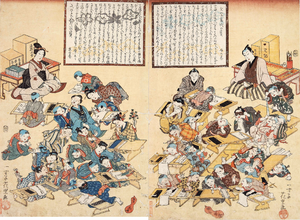
The first shogun Ieyasu set up Confucian academies in his shinpan domains and other daimyos followed suit in their own domains, establishing what's known as han schools (藩校, hankō).[12][18] Within a generation, almost all samurai were literate, as their careers often required knowledge of literary arts.[12] These academies were staffed mostly with other samurai, along with some buddhist and shinto clergymen who were also learned in Neo-Confucianism and the works of Zhu Xi.[12] Beyond kanji (Chinese characters), the Confucian classics, calligraphy, basic arithmetics, and etiquette,[18] the samurai also learned various martial arts and military skills in schools.[12]
The chōnin (urban merchants and artisans) patronized neighborhood schools called terakoya (寺子屋, "temple schools").[12] Despite being located in temples, the terakoya curriculum consisted of basic literacy and arithmetic, instead of literary arts or philosophy.[12] High rates of urban literacy in Edo contributed to the prevalence of novels and other literary forms.[18] In urban areas, children were often taught by masterless samurai, while in rural areas priests from Buddhist temples or Shinto shrines often did the teaching.[18] Unlike in the cities, in rural Japan, only children of prominent farmers would receive education.[18]
In Edo, the shogunate set up several schools under its direct patronage, the most important being the neo-Confucian Shōheikō (昌平黌) acting as a de facto elite school for its bureaucracy but also creating a network of alumni from the whole country. Besides Shoheikō, other important directly-run schools at the end of the shogunate included the Wagakukōdansho (和学講談所, "Institute of Lectures of Japanese classics"), specialized in Japanese domestic history and literature, influencing the rise of kokugaku, and the Igakukan (医学間, "Institute of medicine"), focusing on Chinese medicine.[25]
One estimate of literacy in Edo suggest that up to a third of males could read, along with a sixth of women.[12] Another estimate states that 40% of men and 10% of women by the end of the Edo period were literate.[26] According to another estimate, around 1800, almost 100% of the samurai class and about 50% to 60% of the chōnin (craftsmen and merchants) class and nōmin (peasants) class were literate.[27] Some historians partially credited Japan's relatively high literacy rates for its fast development after the Meiji Restoration.[18]
As the literacy rate was so high that many ordinary people could read books, books in various genres such as cooking, gardening, travel guides, art books, scripts of bunraku (puppet theatre), kibyōshi (satirical novels), sharebon (books on urban culture), kokkeibon (comical books), ninjōbon (romance novel), yomihon and kusazōshi were published. There were 600 to 800 rental bookstores in Edo, and people borrowed or bought these woodblock print books. The best-selling books in this period were Kōshoku Ichidai Otoko (Life of an Amorous Man) by Ihara Saikaku, Nansō Satomi Hakkenden by Takizawa Bakin and Tōkaidōchū Hizakurige by Jippensha Ikku and these books were reprinted many times.[28][27][29][30]
الفلسفة والدين
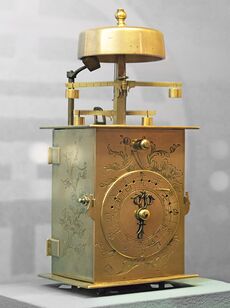
The flourishing of Neo-Confucianism was the major intellectual development of the Tokugawa period.[12] Confucian studies had long been kept active in Japan by Buddhist clerics, but during the Tokugawa period, Confucianism emerged from Buddhist religious control. This system of thought increased attention to a secular view of man and society. The ethical humanism, rationalism, and historical perspective of neo-Confucian doctrine appealed to the official class. By the mid-17th century, neo-Confucianism was Japan's dominant legal philosophy and contributed directly to the development of the kokugaku (national learning) school of thought.
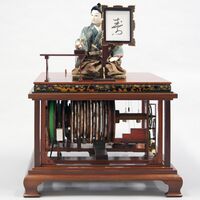
Advanced studies and growing applications of neo-Confucianism contributed to the transition of the social and political order from feudal norms to class- and large-group-oriented practices. The rule of the people or Confucian man was gradually replaced by the rule of law. New laws were developed, and new administrative devices were instituted. A new theory of government and a new vision of society emerged as a means of justifying more comprehensive governance by the bakufu.
Each person had a distinct place in society and was expected to work to fulfill his or her mission in life. The people were to be ruled with benevolence by those whose assigned duty it was to rule. Government was all-powerful but responsible and humane. Although the class system was influenced by neo-Confucianism, it was not identical to it. Whereas soldiers and clergy were at the bottom of the hierarchy in the Chinese model, in Japan, some members of these classes constituted the ruling elite.
Members of the samurai class adhered to bushi traditions with a renewed interest in Japanese history and cultivation of the ways of Confucian scholar-administrators. A distinct culture known as chōnindō ("the way of the townspeople") emerged in cities such as Osaka, Kyoto, and Edo. It encouraged aspiration to bushido qualities—diligence, honesty, honor, loyalty, and frugality—while blending Shinto, neo-Confucian, and Buddhist beliefs. Study of mathematics, astronomy, cartography, engineering, and medicine were also encouraged. Emphasis was placed on quality of workmanship, especially in the arts.
Buddhism and Shinto were both still important in Tokugawa Japan. Buddhism, together with neo-Confucianism, provided standards of social behavior. Although Buddhism was not as politically powerful as it had been in the past, Buddhism continued to be espoused by the upper classes. Proscriptions against Christianity benefited Buddhism in 1640 when the bakufu ordered everyone to register at a temple. The rigid separation of Tokugawa society into han, villages, wards, and households helped reaffirm local Shinto attachments. Shinto provided spiritual support to the political order and was an important tie between the individual and the community. Shinto also helped preserve a sense of national identity.
Shinto eventually assumed an intellectual form as shaped by neo-Confucian rationalism and materialism. The kokugaku movement emerged from the interactions of these two belief systems. Kokugaku contributed to the emperor-centered nationalism of modern Japan and the revival of Shinto as a national creed in the 18th and 19th centuries. The Kojiki, Nihon Shoki, and Man'yōshū were all studied anew in the search for the Japanese spirit. Some purists in the kokugaku movement, such as Motoori Norinaga, even criticized the Confucian and Buddhist influences — in effect, foreign influences — for contaminating Japan's ancient ways. According to them, Japan was the land of the kami and, as such, had a special destiny.[31]
During the period, Japan studied Western sciences and techniques (called rangaku, "Dutch studies") through the information and books received through the Dutch traders in Dejima. The main areas that were studied included geography, medicine, natural sciences, astronomy, art, languages, physical sciences such as the study of electrical phenomena, and mechanical sciences as exemplified by the development of Japanese clockwatches, or wadokei, inspired by Western techniques. Among those who studied mechanical science at that time, Tanaka Hisashige, the founder of Toshiba, is worthy of special mention. Because of the technical originality and sophistication of his Myriad year clock and karakuri puppet, they are difficult to restore even today, and are considered to be a highly mechanical heritage prior to Japan's modernization.[32][33][34]
الفن والثقافة والترفيه
In the field of art, the Rinpa school became popular. The paintings and crafts of the Rinpa school are characterized by highly decorative and showy designs using gold and silver leaves, bold compositions with simplified objects to be drawn, repeated patterns, and a playful spirit. Important figures in the Rinpa school include Hon'ami Kōetsu, Tawaraya Sōtatsu, Ogata Kōrin, Sakai Hōitsu and Suzuki Kiitsu. Other than the Rinpa school, Maruyama Ōkyo and Itō Jakuchū are famous for their realistic painting techniques. They produced their works under the patronage of wealthy merchants newly emerging from the economic development of this period. Following the Azuchi-Momoyama period, the painters of the Kano school drew pictures on the walls and fusumas of castles and temples with the support of powerful people.[35]
Due to the end of the period of civil war and the development of the economy, many crafts with high artistic value were produced. Among the samurai class, arms came to be treated like works of art, and Japanese sword mountings and Japanese armour beautifully decorated with lacquer of maki-e technique and metal carvings became popular. Each han (daimyo domain) encouraged the production of crafts to improve their finances, and crafts such as furnishings and inro beautifully decorated with lacquer, metal or ivory became popular among rich people. The Kaga Domain, which was ruled by the Maeda clan, was especially enthusiastic about promoting crafts, and the area still boasts a reputation that surpasses Kyoto in crafts even today.[36][37]
For the first time, urban populations had the means and leisure time to support a new mass culture. Their search for enjoyment became known as ukiyo (the floating world), an ideal world of fashion, popular entertainment, and the discovery of aesthetic qualities in objects and actions of everyday life. This increasing interest in pursuing recreational activities helped to develop an array of new industries, many of which could be found in an area known as Yoshiwara. The district was known for being the center of Edo's developing sense of elegance and refinement.[38] Established in 1617 as the city's shogunate-sanctioned prostitution district, it kept this designation about 250 years. Yoshiwara was home to mostly women who, due to unfortunate circumstances, found themselves working in this secluded environment.
Professional female entertainers (geisha), music, popular stories, Kabuki (theater) and bunraku (puppet theater), poetry, a rich literature, and art, exemplified by beautiful woodblock prints (known as ukiyo-e), were all part of this flowering of culture. Literature also flourished with the talented examples of the playwright Chikamatsu Monzaemon (1653–1724) and the poet, essayist, and travel writer Matsuo Bashō (1644–1694).
Ukiyo-e is a genre of painting and printmaking that developed in the late 17th century, at first depicting the entertainments of the pleasure districts of Edo, such as courtesans and kabuki actors. Harunobu produced the first full-colour nishiki-e prints in 1765, a form that has become synonymous to most with ukiyo-e. The genre reached a peak in technique towards the end of the century with the works of such artists as Kiyonaga and Utamaro. As the Edo period came to an end a great diversity of genres proliferated: warriors, nature, folklore, and the landscapes of Hokusai and Hiroshige. The genre declined throughout the rest of the century in the face of modernization that saw ukiyo-e as both old-fashioned and laborious to produce compared to Western technologies. Ukiyo-e was a primary part of the wave of Japonisme that swept Western art in the late 19th century.
The Edo period was characterized by an unprecedented series of economic developments (despite termination of contact with the outside world) and cultural maturation, especially in terms of theater, music, and other entertainment. For example, a poetic meter for music called kinsei kouta-chō was invented during this time[39] and is still used today in folk songs. Music and theater were influenced by the social gap between the noble and commoner classes, and different arts became more defined as this gap widened.[40]
Several different types of kabuki emerged. Some, such as shibaraku, were only available at a certain time of year, while some companies only performed for nobles. Fashion trends, satirization of local news stories, and advertisements were often part of kabuki theater, as well.[41] Along with kabuki, storytelling entertainments were popular among the common people, and people enjoyed rakugo, a comical story, and kōdan, a historical story, in a dedicated theater called yose.[42] The most popular sport was sumo.
Eating out became popular due to urbanization. Particularly popular among ordinary people were stalls serving fast food such as soba, sushi, tempura, and unagi, tofu restaurants, teahouses and izakaya (Japanese-style pubs). A number of ryotei also opened to serve high-class food. People enjoyed eating at restaurants by buying books that listed restaurant ratings that imitated sumo rankings.[43][44]
Gardening was a popular pastime. Especially in Edo, residences of daimyo (feudal lords) of each domain were gathered, and many gardeners existed to manage these gardens, which led to the development of horticultural techniques. Among people, cherry blossoms, morning glories, Japanese irises and chrysanthemums were especially popular, and bonsai using deep pots became popular. Not only did people buy plants and appreciate flowers, but they were also enthusiastic about improving the varieties of flowers, so specialized books were published one after another. For example, Matsudaira Sadatomo produced 300 varieties of iris and published a technical book.[45]
Traveling became popular among people because of the improvement of roads and post towns. The main destinations were famous temples and Shinto shrines around the country, and eating and drinking at the inns and prostitution were one of the main attractions. What people admired most was the visit to Ise Grand Shrine and the summit of Mount Fuji, which are considered the most sacred places in Japan. The Ise Grand Shrine in particular has been visited by an enormous number of visitors.[46][47]
Historical documents record that 3.62 million people visited the shrine in 50 days in 1625. 1.18 million people visited it in three days in 1829 when the grand festival held every 20 years (Shikinen Sengu) was held. It was a once-in-a-lifetime event for people living in remote areas, so they set up a joint fund for each village, saved their travel expenses, and went on a group trip. Local residents of Ise Grand Shrine and Mount Fuji used to send specialized advertising personnel to various parts of Japan to solicit trips to local areas to make money from tourism.[48][49]
- Art, culture
Reading stand with Mt. Yoshino, decorated with lacquer of maki-e technique. 18th century
Ukiyo-e based on kabuki actors became popular. Ichikawa Danjūrō V in the popular kabuki play Shibaraku, by Utagawa Kunimasa, 1796
Ukiyo-e depicting Sushi, by Hiroshige
A boarding place for a ferry on the Miya River, which is crowded with people visiting Ise Grand Shrine. By Hiroshige
الموضة
Clothing acquired a wide variety of designs and decorative techniques, especially for kimono worn by women.[50] The main consumers of kimono were the samurai who used lavish clothing and other material luxuries to signal their place at the top of the social order.[51] Driven by this demand, the textile industry grew and used increasingly sophisticated methods of weaving, dyeing, and embroidery.[51] Over this period, women adopted brighter colours and bolder designs, whereas women's and men's kimono had been very similar.[52] The rise of a merchant class fuelled more demand for elaborate costumes. While ordinary kimono would usually be created by women at home, luxurious silk kimono were designed and created by specialist artists who were usually men.[53]
A kind of kimono specific to the military elite is the goshodoki or "palace court style", which would be worn in the residence of a military leader (a shōgun or daimyo). These would have landscape scenes, among which there are other motifs usually referencing classic literature.[54] Samurai men would dress with a more understated design with geometrical designs concentrated around the waist.[55] The yogi, or sleeping kimono, is a thickly wadded form of wearable bedding, usually with simple designs.[56]
A style called tsuma moyō had rich decoration from the waist down only, and family emblems on the neck and shoulders. These would be worn by women of the merchant class.[57] The kimono of merchant-class women were more subdued than those of the samurai, but still with bold colours and designs representing nature.[58]
Red was a popular colour for wealthy women, partly because of its cultural association with youth and passion, and partly because the dye – derived from safflower[59] – was very expensive, so a bright red garment was an ostentatious display of wealth.[60] Indian fabrics, brought to Japan by Dutch importers, were received with enthusiasm and found many uses.[61] Japanese designers started printing designs that were influenced by the Indian patterns.[62] Some garments used fabric imported from Britain or France. Ownership of these exotic textiles signified wealth and taste, but they were worn as undergarments where the designs would not be seen.[63]
Inro and netsuke became popular as accessories among men. Originally, inro was a portable case to put a seal or medicine, and netsuke was a fastener attached to the case, and both were practical tools. However, from the middle of the Edo period, products with high artistic value appeared and became popular as male accessories. Especially samurai and wealthy merchants competed to buy inro of high artistic value. At the end of the Edo period, the artistic value of inro further increased and it came to be regarded as an art collection.[64][65]
نهاية الشگونية
انحدار تكوگاوا

بعد وفاة الشوگون "إيئه-سادا" (徳川) ح(1853-1858 م)، دخلت البلاد أزمة سياسة عاصفة. كانت أطراف عديد تتنازع القرار السياسي، دخل كبار الزعماء من الـ"دائي-ميو" والذي شكلوا ما يعرف بالمحافظين في صراع مع جماعة كانت ترى وجوب الدفع بالبلاد إلى الأمام ومحاربة الركود القائم، كما دار صراع آخر بين جماعة من الذين كانوا يرون وجوب طرد الأجانب من البلاد (الوطنيين) وجماعة أخرى كانت تؤيد عملية انفتاح البلاد على الخارج. قادت كل هذه الأزمات نظام الـ"شوگونية" وببطء نحو الهاوية، كما عجلت بميلاد عهد جديد مع بداية ما عرف ب"فترة مـِيـْجي" سنة 1868 م (سميت الفترة الانتقالية باسم "إستعراش مييجي" نسبة إلى إعادة الإمبراطور إلى عرشه بعد أن كان يحكم البلاد صوريا).
نهاية العزلة
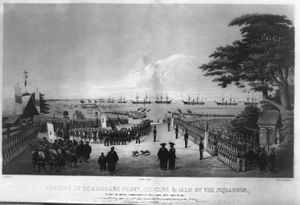
أحداث
- 1600: Battle of Sekigahara. Tokugawa Ieyasu defeats a coalition of daimyo and establishes hegemony over most of Japan.
- 1603: The emperor appoints Tokugawa Ieyasu as shōgun, who moves his government to Edo (Tokyo) and founds the Tokugawa dynasty of shōguns.
- 1605: Tokugawa Ieyasu resigns as shōgun and is succeeded by his son Tokugawa Hidetada.
- 1607: Korean Joseon dynasty sends an embassy to Tokugawa shogunate.
- 1611: Ryūkyū Islands become a vassal state of Satsuma Domain.
- 1614: Tokugawa Ieyasu bans Christianity from Japan.
- 1615: Battle of Osaka. Tokugawa Ieyasu besieges Osaka Castle, all opposition from forces loyal to the Toyotomi family. Tokugawa authority becomes paramount throughout Japan.
- 1616: Tokugawa Ieyasu dies.
- 1620: After Ieyasu dies the peasants and chōnins increase in population
- 1623: Tokugawa Iemitsu becomes the third shōgun.
- 1633: Iemitsu forbids travelling abroad and reading foreign books.
- 1635: Iemitsu formalizes the system of mandatory alternative residence (sankin-kōtai) in Edo.
- 1637: Shimabara Rebellion (1637–38) mounted by overtaxed peasants.
- 1638: Iemitsu forbids ship building.
- 1639: Edicts establishing National Seclusion (Sakoku Rei) are completed. All Westerners except the Dutch are prohibited from entering Japan.
- 1641: Iemitsu bans all foreigners, except Chinese, Koreans, and Dutch from Japan.
- 1657: The Great Fire of Meireki destroys most of the city of Edo.
- 1700: Kabuki and ukiyo-e become popular.[مطلوب توضيح]
- 1707: Mount Fuji erupts.
- 1774: The anatomical text Kaitai Shinsho, the first complete Japanese translation of a Western medical work, is published by Sugita Genpaku and Maeno Ryotaku.
- 1787: Matsudaira Sadanobu becomes senior shogunal councillor and institutes the Kansei Reforms.
- 1792: Russian envoy Adam Laxman arrives at Nemuro in eastern Ezo (now Hokkaidō).
- 1804: Russian envoy Nikolai Rezanov reaches Nagasaki and unsuccessfully seeks the establishment of trade relations with Japan.
- 1837: Rebellion of Ōshio Heihachirō.
- 1841: Tenpō Reforms.
- 1853: US Navy Commodore Matthew C. Perry's four-ship squadron appeared in Edo Bay (Tokyo Bay).
- 1854: The US forces Japan to sign a trade agreement ("Treaty of Kanagawa") which reopens Japan to foreigners after two centuries.
- 1855: Russia and Japan establish diplomatic relations.
- 1860: Sakuradamon Incident.
- 1864: British, French, Dutch and American warships bombard Shimonoseki and open more Japanese ports for foreigners.
- 1868: Tokugawa Yoshinobu resigns, the Tokugawa dynasty ends, and the emperor (or "mikado") Meiji is restored, but with capital in Edo/Tokyo and divine attributes.
أسماء العهود
The imperial eras proclaimed during the Edo period were:[66]
| اسم العهد | Japanese kanji | السنوات التقريبية |
|---|---|---|
| Keichō | 慶長 | 1596~1615 |
| Genna | 元和 | 1615~1624 |
| Kan'ei | 寛永 | 1624~1644 |
| Shōhō | 正保 | 1644~1648 |
| Keian | 慶安 | 1648~1652 |
| Jōō | 承応 | 1652~1655 |
| Meireki | 明暦 | 1655~1658 |
| Manji | 万治 | 1658~1661 |
| Kanbun | 寛文 | 1661~1673 |
| Enpō | 延宝 | 1673~1681 |
| Tenna | 天和 | 1681~1684 |
| Jōkyō | 貞享 | 1684~1688 |
| Genroku | 元禄 | 1688~1704 |
| Hōei | 宝永 | 1704~1711 |
| Shōtoku | 正徳 | 1711~1716 |
| Kyōhō | 享保 | 1716~1736 |
| Genbun | 元文 | 1736~1741 |
| Kanpō | 寛保 | 1741~1744 |
| Enkyō | 延享 | 1744~1748 |
| Kan'en | 寛延 | 1748~1751 |
| Hōreki | 宝暦 | 1751~1764 |
| Meiwa | 明和 | 1764~1772 |
| An'ei | 安永 | 1772~1781 |
| Tenmei | 天明 | 1781~1789 |
| Kansei | 寛政 | 1789~1801 |
| Kyōwa | 享和 | 1801~1804 |
| Bunka | 文化 | 1804~1818 |
| Bunsei | 文政 | 1818~1830 |
| Tenpō | 天保 | 1830~1844 |
| Kōka | 弘化 | 1844~1848 |
| Kaei | 嘉永 | 1848~1854 |
| Ansei | 安政 | 1854~1860 |
| Man'en | 万延 | 1860~1861 |
| Bunkyū | 文久 | 1861~1864 |
| Genji | 元治 | 1864~1865 |
| Keiō | 慶応 | 1865~1868 |
في الثقافة الشعبية
The Edo period is the setting of many works of popular culture. These include novels, comics, stageplays, films, television shows, animated works, and manga.
There is a cultural theme park called Edo Wonderland Nikko Edomura in the Kinugawa Onsen area of Nikkō, Tochigi, north of Tokyo.
انظر أيضاً
- Criminal punishment in Edo-period Japan
- Edomoji, Japanese lettering styles invented in the Edo period
- Ee ja nai ka, an outbreak of mass hysteria at the end of the Edo period
- Gonin Gumi, groups of five households that were held collectively responsible during the Edo period
- Jidaigeki, Japanese period dramas which are usually set in the Edo period
- Jitte (weapon), law enforcement weapon unique to the period
- Karakuri ningyō, Japanese automatons
الهامش
- ^ أ ب "Japan, Christianity and the West during the Edo period". Facts and Details. August 26, 2014. Archived from the original on March 15, 2022.
- ^ Hall & McClain 1991, pp. 369–370
- ^ Hall & McClain 1991, p. 370
- ^ Beasley 1972, p. 22
- ^ Hall, John W. (Autumn 1974). "Rule by Status in Tokugawa Japan". Journal of Japanese Studies. 1 (1): 39–49. doi:10.2307/133436. JSTOR 133436.
- ^ Totman 2000, pp. 225–230.
- ^ Michael Wert, Samurai: A Concise History (2019).
- ^ Lewis 2003, pp. 31–32
- ^ أ ب ت ث Frédéric 2002, p. 313
- ^ أ ب Frédéric 2002, p. 93
- ^ Kozo Yamamura, "Toward a reexamination of the economic history of Tokugawa Japan, 1600–1867." Journal of Economic History 33.3 (1973): 509-546. online
- ^ أ ب ت ث ج ح خ د ذ ر ز س ش ص ض ط ظ ع غ ف ق ك ل م Perez, Louis G. (2009). The history of Japan (2nd ed.). Westport, Conn.: Greenwood Press. ISBN 978-0-313-36442-6. OCLC 277040931.
- ^ أ ب ت Hanley, S. B. (1968). Population trends and economic development in Tokugawa Japan: the case of Bizen province in Okayama. Daedalus, 622-635.
- ^ Flath 2000
- ^ أ ب ت ث Huang, Ray (2015). Capitalism and the 21st Century (Zi ben zhu yi yu er shi yi shi ji) (Di 1 ban ed.). Beijing. ISBN 978-7-108-05368-8. OCLC 953227195.
{{cite book}}: CS1 maint: location missing publisher (link) - ^ أ ب One chō, or chobu, equals 2.45 acres.
- ^ Constantine Nomikos Vaporis, Tour of Duty: Samurai, Military Service in Edo, and the Culture of Early Modern Japan (Honolulu: University of Hawaii Press, 2008), 26.
- ^ أ ب ت ث ج ح خ د ذ ر ز س ش ص ض Hane, Mikiso. Premodern Japan: A historical survey. Routledge, 2018.
- ^ أ ب Totman 2000, chapter 11.
- ^ Sakata Yoshio, Meiji Ishinshi [A history of the Meiji Restoration] (Tokyo: Miraisha, 1960), 19
- ^ McClain, James L. (2002). Japan, a modern history (1st ed.). New York, N.Y.: W.W. Norton & Co. pp. 5–108. ISBN 0-393-04156-5. OCLC 47013231.
- ^ Susan B. Hanley and Kozo Yamamura (1977) Economic and demographic change in preindustrial Japan, 1600–1868, pp. 69–90
- ^ Tetsuji Okazaki (2005). "The role of the merchant coalition in pre-modern Japanese economic development: an historical institutional analysis" (PDF). Explorations in Economic History. 42 (2): 184–201. doi:10.1016/j.eeh.2004.06.005. Archived from the original (PDF) on 2012-05-10.
- ^ Diamond 2005, pp. 297–304
- ^ Kobayashi, Tetsuya (1976). Society, Schools, and Progress in Japan. Pergamon. pp. 14–. ISBN 9781483136226.
- ^ See Martha Tocco, "Norms and texts for women's education in Tokugawa Japan." In Ko, Haboush, and Piggott, Women and Confucian Cultures, 193–218.
- ^ أ ب 第6回 和本の楽しみ方4 江戸の草紙 p.3.. Konosuke Hashiguchi. (2013) Seikei University.
- ^ Edo Picture Books and the Edo Period. National Diet Library.
- ^ Nihonbashi. Mitsui Fudosan.
- ^ Keizaburo Seimaru. (2017) 江戸のベストセラー. Yosensha. ISBN 978-4800312556
- ^ Lewis 2003, pp. 45–47
- ^ Hisashige Tanaka (1799-1881). The Seiko Museum Ginza.
- ^ Mechanism of "Man-nen dokei," a Historic Perpetual Chronometer Yuji Kubota (2005)
- ^ Karakuri Nagoya, Tradition to the modern robot. Shobei Tamaya
- ^ 琳派とは?知っておきたい琳派の巨匠と代表作 January 15, 2019
- ^ Masayuki Murata. 明治工芸入門 p.104. p.120. Me no Me, 2017 ISBN 978-4907211110
- ^ Traditional Crafts of Kanazawa. Archived 2022-01-17 at the Wayback Machine Kanazawa City.
- ^ Longstreet & Longstreet 1989, p. 2
- ^ Hoff, Frank (1978-06-01). Song, dance, storytelling: aspects of the performing arts in Japan (in الإنجليزية). China-Japan Program, Cornell University. p. 130.
- ^ Nishiyama, Matsunosuke (1997). Edo Culture : daily life and diversions in urban Japan, 1600-1868. Translated by Groemer, Gerald. Honolulu, HI: University of Hawaiì Press. pp. 198–227. ISBN 0-585-30952-3. OCLC 45728301.
- ^ Nishiyama, Matsunosuke (1997). Edo Culture : daily life and diversions in urban Japan, 1600-1868. Translated by Groemer, Gerald. Honolulu, HI: University of Hawaiì Press. pp. 198–227. ISBN 0-585-30952-3. OCLC 45728301.
- ^ 寄席早わかり (in اليابانية). Japan Arts Council. Archived from the original on 19 October 2022. Retrieved 5 November 2022.
- ^ 江戸の食文化 外食産業の定着化
- ^ 歴史系総合誌「歴博」第196号 National Museum of Japanese History
- ^ 花開く江戸の園芸 Edo Tokyo Museum
- ^ お伊勢さま、一度は行きたい庶民の夢 Cleanup Corporation
- ^ 富士講と御師 Kitaguchihongu Sengenjinja
- ^ お伊勢さま、一度は行きたい庶民の夢 Cleanup Corporation
- ^ 富士講と御師 Kitaguchihongu Sengenjinja
- ^ Iwao 2015, p. 8.
- ^ أ ب Jackson 2015, p. 20.
- ^ Jackson 2015, p. 22.
- ^ Jackson 2015, p. 24.
- ^ Jackson 2015, pp. 35–44.
- ^ Jackson 2015, pp. 76–78.
- ^ Jackson 2015, pp. 93–95.
- ^ Jackson 2015, pp. 46–51.
- ^ Jackson 2015, p. 54.
- ^ "Kimono". Victoria and Albert Museum (in الإنجليزية). Retrieved 2020-02-20.
- ^ Jackson 2015, p. 63.
- ^ Jackson 2015, p. 80.
- ^ Jackson 2015, pp. 80–84.
- ^ Jackson 2015, p. 87.
- ^ Masayuki Murata. 明治工芸入門 pp.104-106. Me no Me, 2017 ISBN 978-4907211110
- ^ Yūji Yamashita. 明治の細密工芸 p.80-81. Heibonsha, 2014 ISBN 978-4582922172
- ^ "江戸時代の年表・年号" (in اليابانية). July 2019. Retrieved 2020-02-20.
مصادر
- "تاريخ اليابان"
- Japanese Maps of the Tokugawa Era – A rich selection of rare Japanese maps from the UBC Library Digital Collections
- Timeline - JAPAN: Memoirs of a Secret Empire
| سبقه Azuchi-Momoyama period 1573–1603 |
تاريخ اليابان فترة إدو 1603–1868 |
تبعه إمبراطورية اليابان 1868–1945 |
قالب:Tokugawa dynasty (Japan) قالب:Tokugawa chronology (Japan) قالب:Tokugawa Organization Chart قالب:Tokugawa officials
- CS1 maint: location missing publisher
- CS1 uses اليابانية-language script (ja)
- CS1 اليابانية-language sources (ja)
- Short description is different from Wikidata
- Articles with hatnote templates targeting a nonexistent page
- جميع الصفحات التي تحتاج تنظيف
- مقالات بالمعرفة تحتاج توضيح from January 2018
- فترة إدو
- تأسيسات 1603 في اليابان
- القرن 17 في اليابان
- انحلالات 1868 في اليابان
- القرن 18 في اليابان
- القرن 19 في اليابان
- اليابان الإقطاعية
- فترات يابانية
- ولايات وأقاليم انحلت في 1868
- ولايات وأقاليم تأسست في 1603
- تاريخ اليابان
